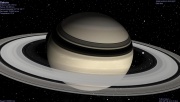Planetary Database/Terran/Saturn
The Planetary Database - Terran System - Saturn
Physical characteristics
Saturn, much like Earth, is an oblate spheroid. It is flattened at the poles and bulging at the equator; its equatorial and polar diameters vary by almost 10% (120,536 km vs. 108,728 km). This is the result of its rapid rotation and fluid state. The other gas planets are also oblate, but to a lesser degree. Saturn is the only one of the Solar System's planets that is less dense than water, with an average specific density of 0.69. This is a mean value; Saturn's upper atmosphere is less dense and its core is considerably more dense than water.
Saturn's interior is similar to Jupiter's, having a rocky core at the center, a liquid metallic hydrogen layer above that, and a molecular hydrogen layer above that. Traces of various ices are also present. Saturn has a very hot interior, reaching 12,000 Kelvin at the core, and it radiates more energy into space than it receives from the Sun. Most of the extra energy is generated by the Kelvin-Helmholtz mechanism (slow gravitational compression), but this alone may not be sufficient to explain Saturn's heat production. An additional proposed mechanism by which Saturn may generate some of its heat is the "raining out" of droplets of helium deep in Saturn's interior, the droplets of helium releasing heat by friction as they fall down through the lighter hydrogen.
Saturn's atmosphere exhibits a banded pattern similar to Jupiter's (in fact, the nomenclature is the same), but Saturn's bands are much fainter and are also much wider near the equator. Saturn's winds are among the Solar System's fastest; Voyager data indicates peak easterly winds of 500 m/s (1116 mph). Saturn's finer cloud patterns were not observed until the Voyager flybys. Since then, however, Earth-based telescopy has improved to the point where regular observations can be made.
Historical
The first Earth probe to visit Saturn was Pioneer 11 in 1979.
During the early 21st century the first manned Earth-Saturn probe was launched, under the command of NASA's Colonel Shaun Geoffrey Christopher.
Saturn was seen on a map depicting the Sol system watched by Nomad. (TOS: "The Changeling")
In early 2367 the invading Borg Cube passed Saturn on it's way towards Earth. (TNG: "The Best of Both Worlds, Part II")
